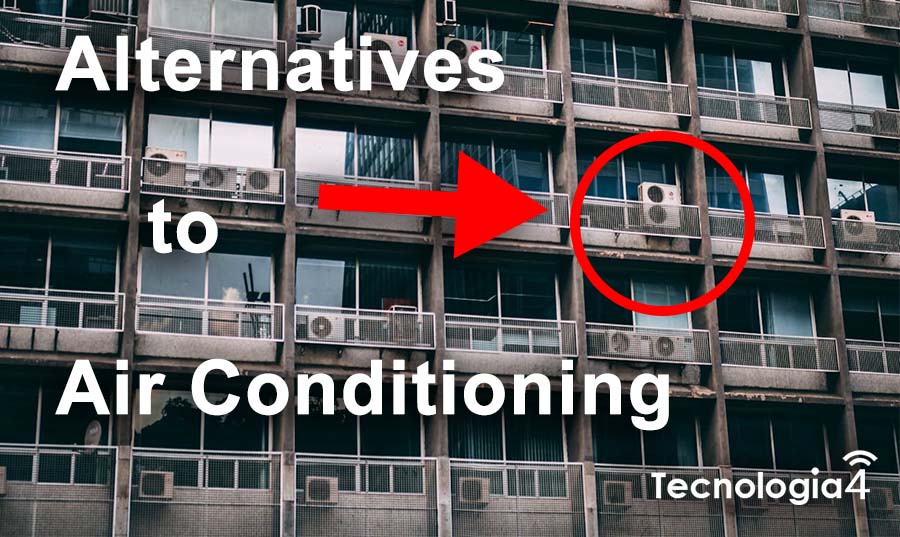Lately, I’ve been thinking a lot about how to keep my home cool without relying so much on air conditioning. I don’t know about you, but when summer hits and temperatures rise, my first reaction is always to turn on the air conditioner. But have you noticed how expensive it can be at the end of the month and how unfriendly it is to the environment? Not to mention how unsightly it looks on building facades or on your house.

So, I started to research some alternatives and honestly, I found a ton of interesting and practical options. From fans and evaporative coolers to natural methods like strategically opening windows or using indoor plants, there are so many ways to stay cool without relying on that noisy and expensive machine.
Also, there’s something very satisfying about finding more sustainable and creative ways to solve everyday problems. So, if you’re also looking to cut down your electricity bill and do a little favor for the planet, keep reading.
1. Fans
The good old fan, the one that feels like a lifesaver when it’s blowing in your face. They are very useful as long as you are near them, and even if the air is hot, if you cool off and direct the fan towards you, they work perfectly.
Ceiling Fans
These are ideal for keeping the air moving in a room. By circulating the air, ceiling fans can make the temperature feel lower than it actually is. Many modern models are also energy-efficient.
Portable Fans
These are a versatile option because you can move them from room to room as needed. There’s a variety of sizes and types, from tower fans to desk fans, and some even come with additional features like humidifiers.
2. Evaporative Coolers
Evaporative coolers, also known as swamp coolers, use the process of water evaporation to cool the air. They are more energy-efficient than traditional air conditioners and work best in dry climates. They are ideal for well-ventilated areas and can lower the temperature by several degrees. Check out the Nexfan Evo as an example.
3. Shade and Insulation
Awnings and Exterior Blinds
Installing awnings or blinds on the exterior of windows can significantly reduce the amount of solar heat entering your home. This is especially useful for south- and west-facing windows.
Thermal Curtains
Thermal curtains are designed to block the heat in summer and retain it in winter. Using them can keep your home cooler without relying on air conditioning.
Proper Insulation
Improving insulation in your home’s roof, walls, and floor can help maintain a more consistent temperature. Insulation acts as a barrier against heat, keeping it out during summer.
4. Natural Methods
These are the most cost-effective methods, which might seem less effective but actually make a difference.
Strategic Window Opening
Opening windows in the early morning and at night when the air is cooler can help refresh your home. During the day, keep them closed to keep the heat out.
Indoor Plants
Some plants help to cool the air and can improve its quality. Plants transpire, releasing moisture into the air and creating a natural cooling effect. Recommended options include areca palm, ficus, and aloe vera.
5. Body Cooling
Although this isn’t a cooling system, it’s important to remember that cooling your body whenever possible is always the most natural option. A quick wash of your face and neck or dressing in light, light-colored clothing always helps.
Appropriate Clothing
Wearing light and breathable clothing made from materials like cotton or linen can help keep you cool. Opt for light colors that reflect the heat.
Cold Showers
Taking a cold shower or wetting your body with damp cloths can provide quick relief from the heat. You can also soak your feet in cold water to lower your body temperature.
6. Passive Cooling Systems
These are my favorites. They require planning at the start, but natural currents, roofs covered with vegetation, or using stone and thick walls to maximize the temperature difference between the exterior and interior make a big difference.
Cross Ventilation
Creating natural air currents by opening windows on opposite sides of the building can help keep the air moving and reduce indoor temperature.
Green Roofs
Covering your roofs with vegetation can lower the internal temperature of your home. Plants absorb heat and provide natural shade.
Building Materials
Using materials that reflect heat, like reflective roofs and light-colored paint on exterior walls, can help keep your home cooler.
7. Advanced Technologies
These systems require an initial investment, but they pay off quickly, especially with today’s electricity prices.
Geothermal Cooling Systems
These systems use the constant temperature of the ground to cool your home. Although the initial installation can be costly, they are very energy-efficient in the long run.
Reflective Window Films
Reflective films can be applied to windows to reduce the amount of solar heat entering your home. These films are easy to install and can make a big difference in indoor temperature.
Smart Windows
Electrochromic windows that activate and darken automatically when the sun hits them can prevent your home from turning into an oven by the time you get back.
And how to save using Air Conditioning?
If none of these solutions convince you, there’s still something you can try. Smart thermostats. Smart thermostats can optimize the use of your cooling and heating systems, ensuring they are used more efficiently and only when necessary.
Conclusion
By implementing a combination of these alternatives, you can create a more comfortable and cool environment in your home without solely relying on air conditioning. Plus, these options can help you save money and reduce your environmental impact.
Hope this helped you!
